Geckeler K.E., Nishide H. (Eds.) Advanced Nanomaterials
Подождите немного. Документ загружается.

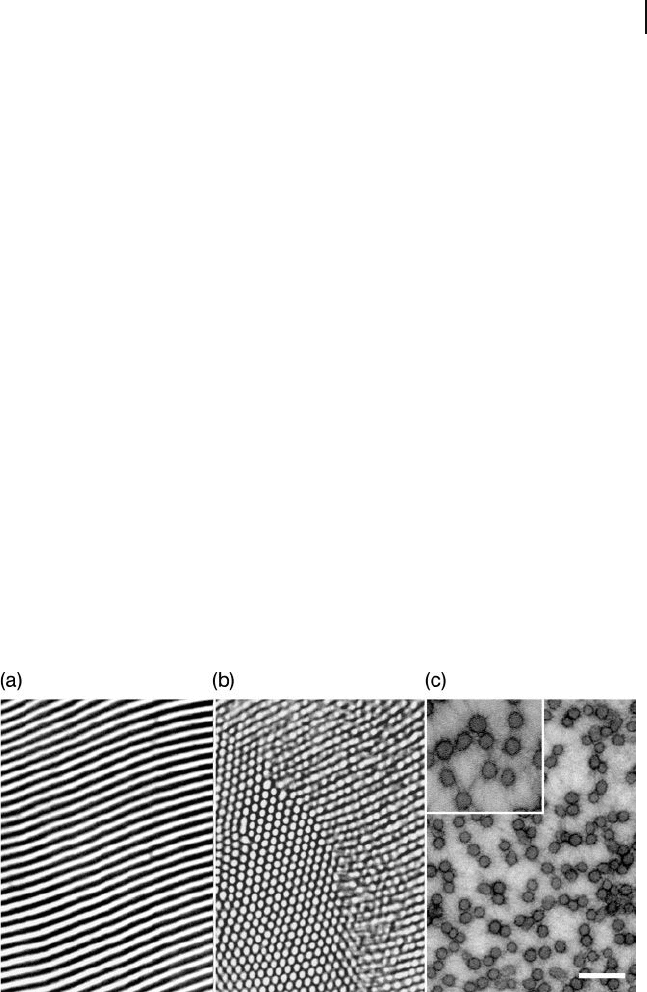
26.2 Block Copolymer Gels 799
system, dielectric measurements provide information regarding the relative move-
ment of chain ends. Since the domain boundaries are immobilized in a quiescent
state at ambient temperature, the SIS copolymer is dielectrically inert [40] . If dipole
inversion is introduced at the center of the midblock, P is proportional to the dif-
ference between the end - to - center vectors. This type of triblock (abbreviated as
SIIS) is dielectrically active even under quiescent conditions. Quantitative com-
parison of the dielectric behavior of SIIS triblock and matched SI diblock copoly-
mers yields [42] a simple expression for the fraction of looped midblocks ( ϕ
L
). For
a triblock copolymer dissolved in n - tetradecane, ϕ
L
is found to decrease from 0.8
to 0.6 as the copolymer concentration is increased from 20 to 50 wt%. The contri-
butions to the overall modulus provided by midblock loops, due to osmotic effects
of microlattice formation, and midblock bridges, due to physical crosslinks,
measure on the same order of magnitude, with the latter being larger by a factor
of 2 – 3 × .
A block - selective solvent can induce morphological transitions in block copoly-
mers because it serves to increase the effective volume fraction of the compatible
block and reduce the effective χ of the system by screening repulsive A – B monomer
contacts. Thus, gels initially possessing a lamellar nanostructure will be trans-
formed into gels with micellar nanostructures (cylindrical or spherical) by increas-
ing the solvent fraction [43] . Representative transmission electron microscopy
( TEM ) images illustrating this morphological progression are provided in Figure
26.5 , in which a microphase - separated SIS triblock copolymer swollen to different
extents in mineral oil exhibits lamellar (Figure 26.5 a), cylindrical (Figure 26.5 b),
and spherical (Figure 26.5 c) morphologies. In these fi gures, the unsaturated
Figure 26.5 Transmission electron
microscopy images of SIS triblock copolymer
organogels portraying several morphologies
at different copolymer concentrations.
(a) Lamellar; (b) Cylindrical; (c) Spherical. In
all three images, the isoprenic midblocks are
selectively stained and appear dark. The inset
in (c) is an enlargement that evinces the
existence of fi ne structure in the solvent - rich
matrix. Scale bar shown in (c) corresponds to
200 nm for (a) and (b), and 100 nm for (c).

800 26 Nanostructured Organogels via Molecular Self-Assembly
isoprenic midblocks are selectively stained and appear dark. In Figure 26.5 c, the
coronas around the periphery of the micelles are delineated. It is important to
recognize that nanoscale strands between and connecting neighboring micelles
are evident in this image (and not in images wherein the styrenic endblocks are
stained), which suggests that some bundles of bridged midblocks are suffi ciently
correlated that they become detectable upon staining. Morphological transitions
in solvated triblock copolymer systems can be accompanied by abrupt changes in
mechanical properties, such as the plateau or tensile moduli [44] , and are readily
identifi ed by small - angle scattering patterns, such as those shown in Figure 26.6 ,
due to signature peak ratios corresponding to various ordered morphologies [43] .
While relatively few studies have systematically addressed the phase behavior of
triblock copolymers in the presence of an organic solvent, Lodge and coworkers
[19] have broadly scrutinized the effects of solvent concentration and selectivity on
the phase behavior of diblock copolymers.
It is appropriate at this juncture to mention that several published reports
[45, 46] describe diblock copolymer gels. Diblock copolymer molecules swollen in
a selective solvent can self - organize into the same morphologies observed for
solvated triblock copolymers, but there remains an important molecular - level dif-
ference. In a micellar morphology, for the sake of illustration, diblock copolymer
molecules can only adopt a tail topology wherein the solvent - incompatible block
forms the micellar core and the solvent - compatible block accounts for the solvent -
swollen corona. Intermicellar bridging is not possible. At low copolymer concen-
trations, such systems behave as suspensions of soft particles. As the copolymer
concentration is increased, the micelles order on a cubic lattice, a process that has
been referred to as “ microlattice structuring ” [47] . Watanabe and Kotaka [48] have
studied the microlattice formation of SI diblock copolymers in n - tetradecane, an
I - selective solvent. In moderately concentrated solutions, overlapping coronas
Figure 26.6 Small - angle X - ray scattering (SAXS) patterns
acquired from SEPS triblock copolymer organogels varying in
morphology (as labeled) due to differences in copolymer
concentration at ambient temperature.

26.2 Block Copolymer Gels 801
assume random conformations to maximize the conformational entropy, but are
forced to maintain a uniform concentration distribution to minimize the free
energy. A compromise yields mutually correlated microdomains with overlapping
(and thus entangled) coronal blocks. When a small strain is applied, the local
variation in concentration promotes an osmotic pressure gradient, which,
in turn, generates a restoring force. Micellar solutions of diblock copolymers
at moderate or high concentrations are elastic below a “ yield ” point. These
systems, although gel - like at low strains, are not strictly considered organogels, as
they undergo relaxation at ambient temperature. The presence of bridges in tri-
block copolymer organogels serves to increase relaxation times, so that at suffi -
ciently high copolymer concentrations ( c > cgc) and molecular weights, the
copolymer network never relaxes at ambient temperature, which explains why G ′
is independent of frequency in rheological tests. Because of the copolymer network,
SAMINs derived from triblock copolymers can undergo large strains and subse-
quently snap back to their original shape, indicating that they possess shape
memory.
26.2.2
Temperature Effects
At ambient temperature, a TPEG behaves as an elastic solid with relatively little
hysteresis (i.e., nonrecoverable, or permanent, strain) induced upon cycling. When
the temperature is raised above the T
g
of the endblocks, the network - stabilizing
crosslinks soften, and the gel transforms into a viscoelastic liquid with a distinct
yield stress due to pull - out of endblocks from their microdomains upon deforma-
tion. According to dynamic rheological analysis, the glass transition is manifested
by a small decrease in the storage modulus ( G ′ ) and a broad maximum in the loss
modulus ( G ′ ′ ) [49] . Care must be taken, however, not to confuse the endblock glass
transition with other copolymer transitions, such as order – order transition s
( OOT s), corresponding to morphological transformations, and the order – disorder
transition ( ODT ), sometimes termed the lattice - disordering transition. In the latter
case, long - range (lattice) order is replaced by short - range (liquid - like) order, and
G ′ is observed to drop precipitously. This progression [50] is illustrated schemati-
cally in Figure 26.7 , in which cmT denotes the critical micelle temperature (i.e.,
the temperature at which micelles spontaneously form at constant concentration).
Structural transitions such as OOTs and the ODT lie between the cmT and the
endblock T
g
. It must be recognized that all these transition temperatures depend
on factors such as endblock size and endblock – solvent compatibility at elevated
temperatures [22] .
The dynamics of micelles in block copolymer gels have attracted considerable
attention. In small - molecule (i.e., surfactant - based) micellar systems, micelle
exchange is a well - documented phenomenon [51] . As alluded to above, under
favorable conditions, block copolymer organogels can exhibit similar behavior.
Watanabe and coworkers [52] , for instance, have investigated network disruption
and recovery of poly( butadiene - b - styrene - b - butadiene ) ( BSB ) triblock copolymers
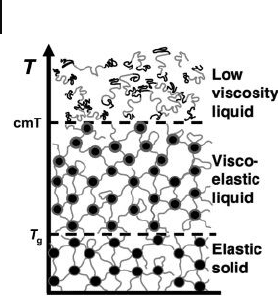
802 26 Nanostructured Organogels via Molecular Self-Assembly
in dibutyl phthalate, an S - selective solvent, using dielectric spectroscopy. Unlike
conventional TPEGs with endblocks that form glassy crosslinks, solvated systems
composed of BSB copolymer molecules consist of soft, deformable crosslinks that
can experience chain pullout. When a large stress is applied at ambient tempera-
ture ( T > > T
g
of the endblocks), fl ow is restricted to pre - existing lattice defects.
During shear, bridges across the defect plane convert to loops, which has likewise
been observed [53] in triblock copolymer melts. This change in chain conformation
generates a force that causes the micelles to migrate away from the defect plane.
Some loops produced in this fashion mix transiently with the matrix, thereby
forming dangling ends. A full recovery of the network upon cessation of shear is
achieved when the thermodynamically unequilibrated dangling ends reform into
bridges. Thus, the time for recovery is a function of the thermodynamic stability
of the dangling end, which is a shear - independent relationship.
Another aspect of organogel dynamics that warrants close examination pertains
to the kinetics of ordering and disordering at temperatures in close proximity to
the ODT. Bansil et al . [54] have employed time - resolved small - angle X - ray scatter-
ing ( SAXS ) to probe the kinetics associated with the nanostructural (dis)ordering
of organogels containing 20 wt% poly[ styrene - b - (ethylene - co - butylene) - b - styrene ]
( SEBS ) triblock copolymer. In this case, the kinetics of ordering upon cooling are
found to be much slower (on the order of hours) than those of disordering upon
heating (on the order of seconds). Upon slow cooling ramps, the effective volume
fraction of hard spheres deduced from the Percus – Yevick scattering model [55]
initially increases to a maximum of ∼ 0.52 (indicating an increase in order) near
the ODT, and then decreases slowly. At lower temperatures, Bragg peaks become
discernible and increase in intensity, indicating that the system has ordered into
a body - centered - cubic (bcc) lattice. This change is accompanied by a small, but
abrupt, reduction in micelle size. The ordering transition has also been studied
by performing a thermal quench from 140 ° C (at which the gel is completely dis-
Figure 26.7 Schematic diagram showing the
effect of temperature on the micellar network
formed in triblock copolymer organogels. Not
included here is the order – disorder transition
(ODT), if it exists at the copolymer
concentration of interest. This progression
implicitly presumes that c > cgc. Adapted
from Ref. [50] and used with permission from
the American Chemical Society.
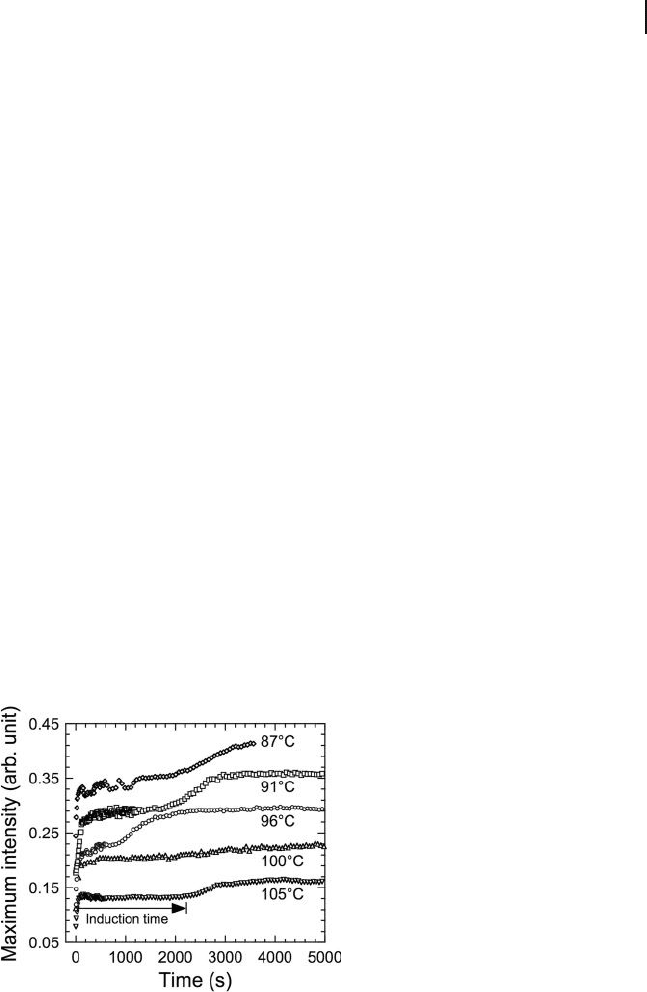
26.2 Block Copolymer Gels 803
ordered) to a temperature below T
ODT
, but above T
g
. Two distinguishable stages
are evident from the results, as shown in Figure 26.8 . During an induction period
( ∼ 1000 s or more after quenching), no change in the maximum SAXS intensity is
evident, initially due to thermal equilibration and then to micelle supercooling.
An analysis of the scattering curves by the Percus – Yevick model [56] indicates that
the hard sphere volume fraction increases to ∼ 0.53, which precedes the appearance
of scattering refl ections. Nucleation and growth of the ordered nanostructure
occur during the second stage of structural development and account for an
increase in scattering intensity at Bragg peak positions. The duration of the induc-
tion time depends on the depth of the thermal quench, exhibiting a minimum at
an intermediate temperature between T
ODT
and T
g
. This observation suggests that
a competition exists between the driving force for ordering, which increases at
deeper quenches, and chain mobility, which is reduced at lower temperatures.
As alluded to earlier, block copolymer gels subjected to a thermal ramp can,
under favorable conditions, also transform from one morphology to another at an
OOT temperature. In this case, the initial morphology is either cylindrical or
lamellar. Starting with a gel composed of a SEBS triblock copolymer swollen with
a midblock - selective solvent and exhibiting the cylindrical morphology, Li et al .
[57] have examined the transformation kinetics from hexagonally packed cylinders
to bcc spheres by performing temperature - jump SAXS. Knowing the OOT and
ODT temperatures (127 and 180 ° C, respectively) from complementary rheological
and SAXS measurements, temperature jumps between the OOT and ODT could
be used to follow the mechanism of cylinder → sphere transformation. For tem-
peratures up to ∼ 145 ° C, this structural evolution proceeds by a three - stage nuclea-
tion and growth process. In the fi rst (incubation) stage, the cylinders retain their
Figure 26.8 Time evolution of the maximum
SAXS intensity for a triblock copolymer
organogel with 20 wt% copolymer quenched
from a temperature above the ODT to
different temperatures (as labeled) below the
ODT. The induction time (labeled for data
acquired at 105 ° C) corresponds to the time
before the maximum intensity undergoes a
nearly stepwise increase. Adapted from Ref.
[54] and used with permission from the
American Chemical Society.
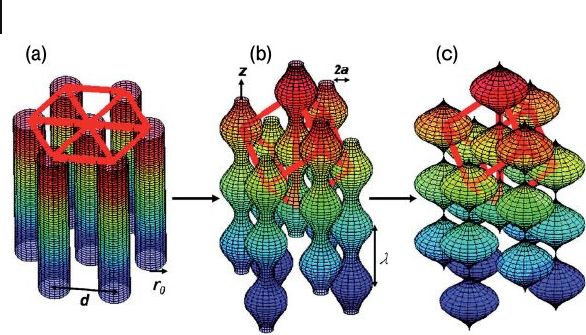
804 26 Nanostructured Organogels via Molecular Self-Assembly
shape, but a shift in the principal scattering peak indicates a reduction in the
distance between cylinders. A critical number of cylinders rupture into modulated
spheres during the second stage. These regions serve as nucleation sites to promote
further rupture of cylinders and modulation of weakly correlated spheres in an
outgoing ripple. Lastly, the spheres order on a bcc lattice so that the (100) plane
of the hexagonal cylinders becomes the (110) plane of the bcc spheres and the
cylinder axis evolves into the < 111 > direction of the bcc spheres, as illustrated in
Figure 26.9 . At temperatures beyond 150 ° C, the fi rst two stages coincide, and the
mechanism commences via spinodal decomposition in which the cylinders trans-
form directly into disordered spheres by correlated ripples. Above the ODT, the
temperature jump permits formation of transient bcc spheres prior to disordering.
Qualitatively similar results have been reported [58] for the transition from lamel-
lae to cylinders in a triblock copolymer gel consisting of an endblock - selective
solvent. Although no studies to date have examined the kinetics of OOTs in block
copolymer gels upon cooling, corresponding efforts performed experimentally [59]
and theoretically [60] on solvent - free copolymers have likewise revealed that the
sphere → cylinder transformation occurs by a nucleation and growth process, the
details of which are sensitive to the depth of the thermal quench used to promote
the transition.
26.2.3
Microdomain Alignment
Microdomains that form by molecular self - organization in a block copolymer
organogel, such as a TPEG, frequently appear deformed due to interfacial packing
frustration that occurs during rapid solvent evaporation or thermal quenching. In
either case, specimen processing can promote metastable conformations that
Figure 26.9 Scheme depicting the
temperature - induced time evolution of
hexagonally packed cylinders to bcc spheres
in triblock copolymer organogels. Initial and
subsequently modulated cylinders are
displayed in (a) and (b), respectively, whereas
cylinder break - up into spheres is portrayed in
(c). The solid lines follow the accompanying
crystallographic development discussed in the
text. Reproduced from Ref. [57] and used with
permission from the American Chemical
Society.
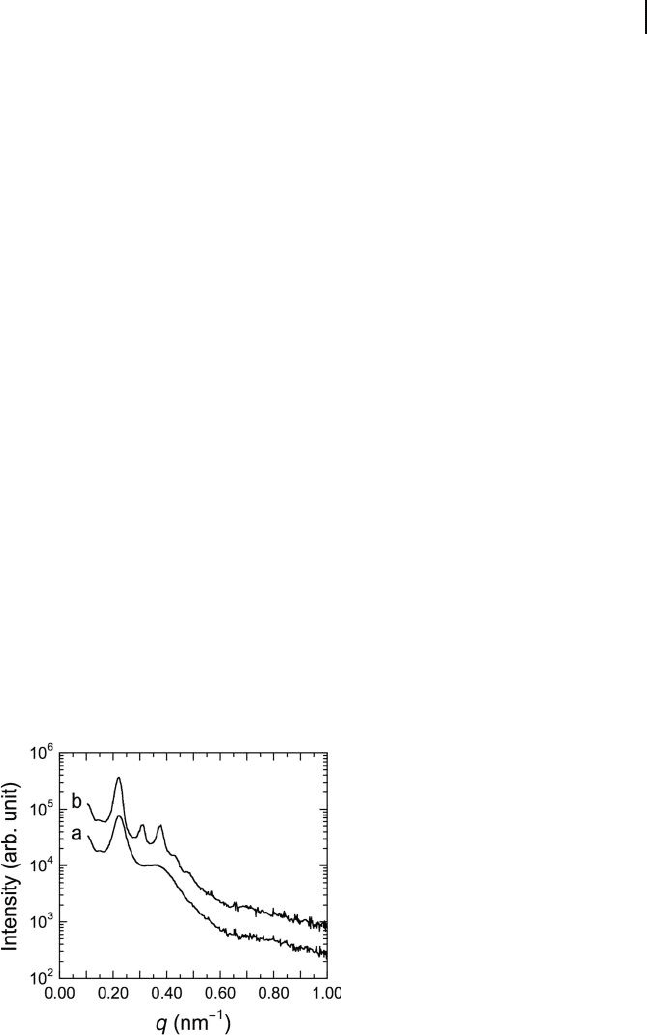
26.2 Block Copolymer Gels 805
become frozen - in once the endblocks undergo vitrifi cation. It immediately follows,
then, that increasing the temperature of such gels above the endblock T
g
should
give the endblocks ample opportunity to relax and redistribute, and the nanostruc-
ture time to equilibrate. Quenching of such ordered gels to temperatures below
the endblock T
g
should again lock - in the morphology, even though it is nonequi-
librium at the lower temperature. Independent efforts [32, 61, 62] have explored
the effect of annealing on the morphologies and properties of organogels com-
posed of SEBS copolymers. Laurer et al . [32] have directly observed moderately
improved long - range order in annealed gels by TEM, whereas Soenen et al . [61,
62] have reported an increase in the number of peaks in SAXS patterns of gels
upon annealing. Although annealing in the melt can enhance the nanostructural
order of block copolymer organogels, it remains unclear that long - time annealing
serves to either improve their mechanical properties or alter their phase
behavior.
Similar structural results (cf. Figure 26.10 ) have been purported by Kleppinger
et al . [63, 64] , who have also shown that SAXS patterns acquired from gels,
annealed or otherwise, retain a broad structure factor maximum at high tempera-
tures, indicating that network clusters remain. For gels possessing intermicellar
distances such that the midblocks behave as statistical coils, an abrupt transforma-
tion to the bcc morphology proceeds upon annealing in the melt [65, 66] . This
morphology is preserved even after cooling below T
g
. For gels with higher copoly-
mer concentrations and compressed midblocks, the bcc morphology eventually
forms upon longer annealing times. In this case, a temperature increase promotes
an increase in midblock gyration radius, thus improving orientational order. At
lower temperatures, this morphology is nonequilibrium, which may result in
lattice distortion due to frustration of close - packed spheres. An alternative route
to improved microdomain orientation in block copolymer gels involves shear -
Figure 26.10 SAXS patterns obtained from
triblock copolymer organogels with 20 wt%
copolymer under two different thermal
conditions. (a) Quenched and unannealed;
(b) Quenched and annealed at 90 ° C for 24 h.
The higher - order Bragg diffraction peaks in
(b) identify the morphology as bcc spheres.
Adapted from Ref. [63] and used with
permission from John Wiley & Sons, Inc.
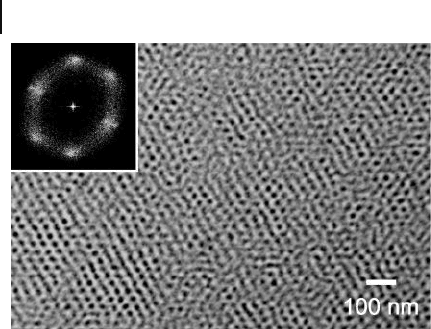
806 26 Nanostructured Organogels via Molecular Self-Assembly
induced disordering and reordering [64] . After the gel has been preannealed to
form a bcc morphology, a large - amplitude oscillatory shear is applied to disrupt
the nanostructure. Upon reordering, the gel exhibits a highly ordered, single -
crystal, twinned bcc morphology, as depicted in Figure 26.11 . Thus, a combination
of thermal and shear treatment can be used to achieve single - crystal order in block
copolymer gels. By surveying a range of strain amplitudes and frequencies,
Mortensen et al . [67] have developed a morphology diagram (cf. Figure 26.12 ) that
establishes the conditions under which block copolymer gels can be highly ori-
ented. Orientation refi nement is found to occur only in the frequency range where
G ′ ′ ≈ G ′ , and long shear times are required for dislocation planes to form.
26.2.4
Tensile Deformation
Reynaers and coworkers [68] have subjected disordered SEBS and poly[ styrene - b -
(ethylene - co - propylene) - b - styrene ] ( SEPS ) gels to moderate uniaxial strains (up to
100%) and elucidated the resultant nanostructure by small - angle neutron scatter-
ing ( SANS ), as illustrated in Figure 26.13 . Affi ne deformation of the supramolecu-
lar network is observed only at high copolymer concentrations, which favor
entanglement of the copolymer midblocks. According to Prasman and Thomas
[69] , Poisson ’ s ratio must remain constant to achieve affi ne deformation. At lower
copolymer fractions, stretching in one direction up to 100% strain promotes the
formation of distinct diffraction spots along the strain direction (Figure 26.13 a)
and well - defi ned layers of ordered micelles normal to the strain direction (Figure
26.13 b). At higher strains (up to 1000%), however, the corresponding SANS
patterns appear markedly different [70] . Between 200 and 400% strain, the patterns
Figure 26.11 Transmission electron
microscopy image of a triblock copolymer
organogel composed of 20 wt% copolymer
and subjected to large - amplitude oscillatory
shear to induce nanostructural alignment. In
contrast to Figure 26.5 , the styrenic endblocks
are selectively stained and appear dark. The
inset is a 2 - D Fourier transform of the image
to confi rm the high degree of order in this
specimen.
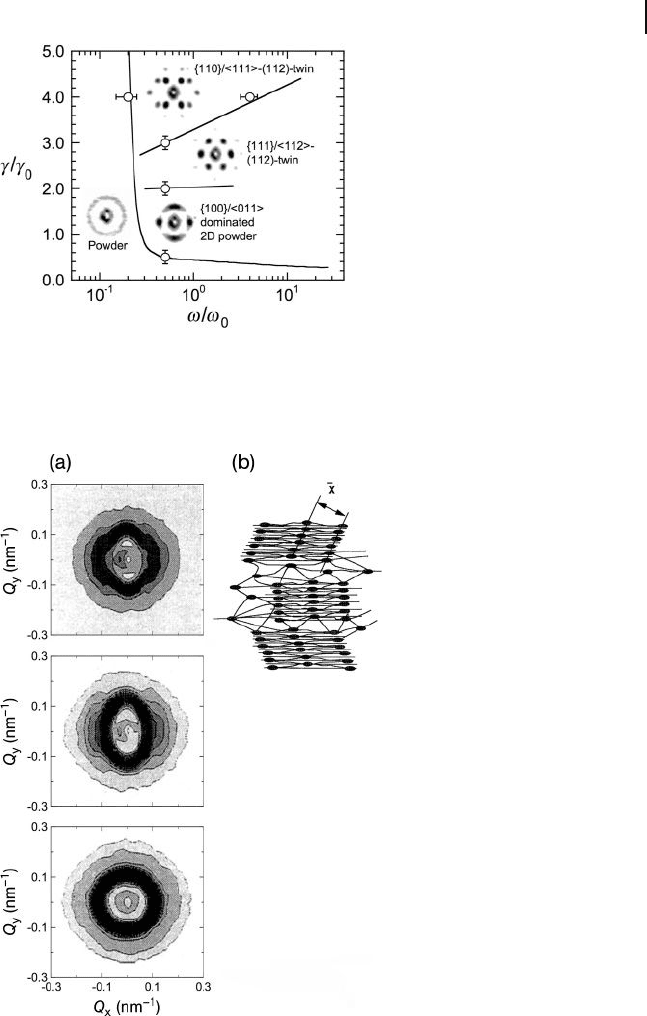
26.2 Block Copolymer Gels 807
Figure 26.12 Normalized strain - frequency ( γ - ω ) diagram
revealing the dynamic shear conditions under which a triblock
copolymer organogel can be highly oriented into a twinned
bcc spherical morphology. Adapted from Ref. [67] and used
with permission from the American Chemical Society.
Figure 26.13 (a) 2 - D SANS patterns of
triblock copolymer organogels consisting of
18 wt% SEPS copolymer and subjected to
different uniaxial tensile strains: (bottom) 0%,
(middle) 50%, (top) 100%; (b) A clustered
micelle arrangement consistent with
experimental observations that SANS patterns
do not change beyond a particular strain level.
Adapted from Ref. [14] and used with
permission from the American Chemical
Society.

808 26 Nanostructured Organogels via Molecular Self-Assembly
become more diffuse, clearly indicating distortion of the regular layers formed at
lower strains. Above 400% strain, no structural changes are detectable at the length
scales probed by SANS. This observation has been interpreted to mean that (i) the
strained network consists of large, discrete clusters similar to those that develop
at the sol – gel transition upon initial network formation; and (ii) these clusters vary
in the extent of their connectivity. Cluster boundaries, for instance, possess fewer
crosslink sites than the clusters themselves, and are thus more deformable than
the clusters, which saturate and produce no further structural changes at high
strains. Krishnan [71] has employed SAXS to examine the response of SEBS gels
to biaxial tensile deformation up to 300% × 300% strain, and has found, by using
the Percus – Yevick scattering model [72] incorporating a square - shoulder potential,
that the micelles remain (for the most part) spherical and that the micellar coronas
increasingly overlap with escalating strain. Kleppinger et al . [73] have likewise
investigated the conditions responsible for affi ne behavior when SEBS gels are
subjected to uniaxial strain. Affi ne behavior is observed in unannealed SEBS gels
at high extension rates, while nonaffi ne behavior is dominant at low extension
rates. If, however, a gel is preannealed so that the micellar nanostructure exhibits
long - range order prior to deformation, then affi ne behavior is realized even at low
extension rates.
Uniaxial tensile deformation of triblock copolymer gels deviates from the predic-
tions of classical rubber elasticity [74] , and is therefore often described in terms
of the semi - empirical Mooney – Rivlin model [75, 76] that initially was developed
for chemically crosslinked elastomers. A more recent attempt to relate the bulk
physical behavior of triblock copolymer gels to their underlying nanoscopic
network is the STN model [37] , as introduced in Section 26.2.1 . In this model, the
measured nominal (or engineering) stress ( σ ) is given by
σ
λ
λ
λ
φ
=
()
⎛
⎝
⎜
⎞
⎠
⎟
−
()
()
G
G
g
f
c
e
+
1
2
, Φ (26.5)
where G
c
and G
e
denote the contributions of permanent crosslinks and transient
entanglements, respectively, to G . Here, g ( λ ) = 0.74 λ + 0.61 λ
− 1/2
− 0.35, where λ
represents the extension ratio, and f ( φ , Φ ) depends on the concentration of hard
fi ller ( φ ) – for example, glassy micelles, governed by the composition of the copoly-
mer – and the copolymer volume fraction ( Φ ). Shankar et al . [31] have demon-
strated that this model can provide valuable insight into molecular factors, such
as the copolymer chain length ( N ), that infl uence gel network formation and
properties.
26.2.5
Network Modifi ers
26.2.5.1 Inorganic Nanofi llers
Due to a growing interest in hybrid organic – inorganic nanocomposites [77] ,
several studies [49, 78 – 83] have recently addressed the effects of inorganic nano-
